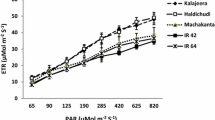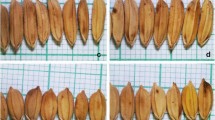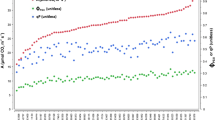Abstract
In order to evaluate genotypic variation, we measured leaf photosynthetic rate (Pn) and its associated factors for the rice diversity research set of germplasm (RDRS) selected from the Genebank in National Institute of Agrobiological Sciences (NIAS). Pn showed large genotypic variation from 11.9 to 32.1 μmol m−2 s−1. The variation in stomatal conductance to CO2 (Gs) explained about 50% of that in Pn, while that in nitrogen concentration (N) in leaves explained about 35%. The genotype group which mainly consists of aus type indica tended to have higher Gs, and the genotype group which corresponds to japonica had a higher nitrogen concentration (N) in leaves. The relationships of Pn with Gs and N were not significantly different among genotype groups, suggesting photosynthetic efficiencies are similar among genotype groups.






Similar content being viewed by others
Notes
When RDRS was distributed to us, RDRS consisted of 64 genotypes. The latest RDRS included five genotypes more (Kojima et al. 2005).
Abbreviations
- 1WAH:
-
1 week after heading
- 2WBH:
-
2 weeks before heading
- Δ:
-
Carbon isotope discrimination
- Ci :
-
Intercellular CO2 concentration
- Ca :
-
Ambient CO2 concentration
- DTH:
-
Days to heading from sowing
- Gs :
-
Stomatal conductance to CO2
- I1:
-
A genotype group corresponding to aus type indica
- I2:
-
A genotype group corresponding to indica except aus
- J:
-
A genotype group corresponding to japonica
- N:
-
Nitrogen weight per unit leaf area
- N%:
-
Nitrogen percentage in leaf dry matter
- PAR:
-
Photosynthetically active radiation
- Pn:
-
Leaf photosynthetic rate
- QTL:
-
Quantitative trait loci
- RFLP:
-
Restriction fragment length polymorphism
- SSR:
-
Single-sequence repeat
- RDRS:
-
Rice diversity research set of germplasm
- RubisCO:
-
Ribulose-1,5-bisphosphate carboxylase/oxygenase
- VPD:
-
Vapor pressure deficit
References
Angström A (1924) Solar and terrestrial radiation. Quart J Roy Met Soc 50:121–126
Ashikari M, Matsuoka M (2006) Identification, isolation and pyramiding of quantitative trait loci for rice breeding. Trends Plant Sci 11:344–350
Cook MG, Evans LT (1983) Nutrient responses of seedlings of wild and cultivated Oryza species. Field Crops Res 6:205–518
Cui J, Kusutani A, Toyota M, Asanuma K (2000) Studies on the varietal difference of harvest index in rice. Relationship between harvest index and morphological characteristics and leaf color. Jpn J Crop Sci 69:365–371 [In Japanese with English abstract]
Evans JR, Sharkey D, Berry JA, Farquhar GD (1986) Carbon isotope discrimination measured concurrently with gas exchange to investigate CO2 diffusion in leaves of higher plants. Aust J Plant Physiol 13:281–292
Evans JR, von Caemmerer S, Setchell BA, Hudson GS (1994) The relationship between CO2 transfer conductance and leaf anatomy in transgenic tobacco with a reduced content of Rubisco. Aust J Plant Physiol 21:475–495
Farquhar GD, O’Leary MH, Berry JA (1982) On the relationship between carbon isotope discrimination and the intercellular carbon dioxide concentration in leaves. Aust J Plant Physiol 9:121–137
Garris AJ, Tai TH, Coburn J, Kresovich S, McCouch S (2005) Genetic structure and diversity in Oryza sativa L. Genetics 169:1631–1638
Hikosaka K, Hanba YT, Hirose T, Terashima I (1998) Photosynthetic nitrogen-use efficiency in leaves of woody and herbaceous species. Funct Ecol 12:896–905
Horie T, Lubis I, Takai T, Ohsumi A, Kuwasaki K, Katsura K, Nii A (2003) Physiological traits associated with high yield potential in rice. In: Mew TW, Brar DS, Peng S, Dawe D, Hardy B (eds) Rice science: innovations and impact for livelihood. Proceedings of the international rice research conference, Beijing, September 2002. IRRI, Chinese Academy of Engineering and Chinese Academy of Agricultural Sciences, Beijing, pp 117–145
Ishimaru K, Yano M, Aoki N, Ono K, Hirose T, Lin SY, Monna L, Sasaki T, Ohsugi R (2001) Toward the mapping of physiological and agronomic characters on a rice function map: QTL analysis and comparison between QTLs and expressed sequence tags. Theor Appl Genet 102:793–800
Kawamitsu Y, Agata W (1987) Varietal differences in photosynthetic rate, transpiration rate and leaf conductance for leaves of rice plants. Jpn J Crop Sci 53:563–570 [in Japanese with English summary]
Kondo M, Pablico PP, Aragones DV, Agbisit R (2004) Genotypic variations in carbon isotope discrimination, transpiration efficiency, and biomass production in rice as affected by soil water conditions and N. Plant Soil 267:165–177
Kojima Y, Ebana K, Fukuoka S, Nagamine T, Kawase M (2005) Development of an RFLP-based rice diversity research set of germplasm. Breed Sci 55:431–440
Kuroda E, Kumura A (1990) Difference in single leaf photosynthesis between old and new rice varieties. III. Physiological bases of varietal difference in single-leaf photosynthesis between varieties viewed from nitrogen content and the nitrogen–photosynthesis relationship. Jpn J Crop Sci 59:298–302 [in Japanese with English abstract]
Mackill DJ (1999) Genome analysis and breeding. In: Shimamoto K (ed) Molecular biology of rice. Springer-Verlag, Tokyo, pp 17–41
Makino A, Mae T, Ohira K (1987) Variations in the contents and kinetic-properties of ribulose-1,5-bisphosphate carboxylases among rice species. Plant Cell Physiol 28:799–804
Maruyama S, Tajima K (1990) Leaf conductance in japonica and indica rice varieties. I. Size, frequency, and aperture of stomata. Jpn J Crop Sci 59:801–808
Ohsumi A, Hamasaki A, Nakagawa H, Yoshida H, Shiraiwa T, Horie T (2007a) A model explaining genotypic and ontogenetic variation of leaf photosynthetic rate in rice (Oryza sativa) based on leaf nitrogen content and stomatal conductance. Annals Bot 99:265–273
Ohsumi A, Kanemura T, Homma K, Horie T, Shiraiwa T (2007b) Genotypic variation of stomatal conductance in relation to stomatal density and length in rice (Oryza sativa L.). Plant Prod Sci 10:322–328
Peng S, Cassman KG, Virmani SS, Sheehy J, Khush GS (1999) Yield potential trends of tropical rice since the release of IR8 and the challenge of increasing rice yield potential. Crop Sci 39:1552–1559
Rasmusson DC (1991) A plant breeder’s experience with ideotype breeding. Field Crops Res 26:191–200
Saitoh K, Shimoda H, Ishihara K (1991) Characteristics of dry matter production process in high yielding rice varieties. III. Comparisons of leaf photosynthesis. Jpn J Crop Sci 60:65–74 [in Japanese with English abstract]
Sasaki H, Ishii R (1992) Cultivar differences in leaf photosynthesis of rice bred in Japan. Photosyn Res 32:139–146
Sinclair TR, Horie T (1989) Leaf nitrogen, photosynthesis, and crop radiation use efficency: a review. Crop Sci 29:90–98
Takai T, Fukuta Y, Sugimoto A, Shiraiwa T, Horie T (2006) Mapping of QTLs controlling carbon isotope discrimination in the photosynthetic system using recombinant inbred lines derived from a cross between two different rice (Oryza sativa L.) cultivars. Plant Prod Sci 9:271–280
Teng S, Qian Q, Zeng DL, Kunihiro Y, Fujimoto K, Huang DN, Zhu LH (2004) QTL analysis of leaf photosynthetic rate and related physiological traits in rice (Oryza sativa L.). Euphytica 135:1–7
Xu YF, Ookawa T, Ishihara K (1997) Analysis of the photosynthetic characteristics of the high-yielding rice cultivar Takanari. Jpn J Crop Sci 66:616–623 [In Japanese with English abstract]
Acknowledgments
Rice diverse research set of germplasm (RDRS) used in this study was distributed by the Genebank of the National Institute of Agrobiological Science (NIAS), Japan. Special thanks are due to Dr. K. Ebana and Dr. Y. Uga of the NIAS for their comments to this study. We also thank Dr. T. Takai for giving us the information of RDRS.
Author information
Authors and Affiliations
Corresponding author
Electronic supplementary material
Below is the link to the electronic supplementary material.
Rights and permissions
About this article
Cite this article
Kanemura, T., Homma, K., Ohsumi, A. et al. Evaluation of genotypic variation in leaf photosynthetic rate and its associated factors by using rice diversity research set of germplasm. Photosynth Res 94, 23–30 (2007). https://doi.org/10.1007/s11120-007-9208-7
Received:
Accepted:
Published:
Issue Date:
DOI: https://doi.org/10.1007/s11120-007-9208-7




